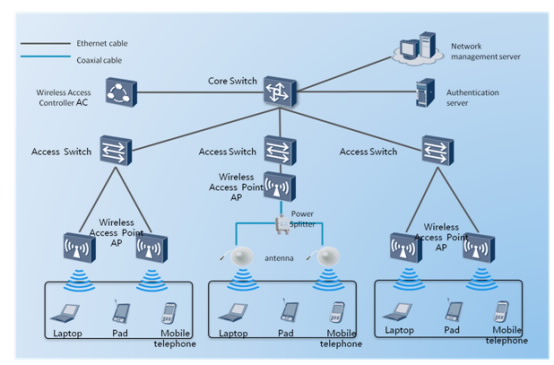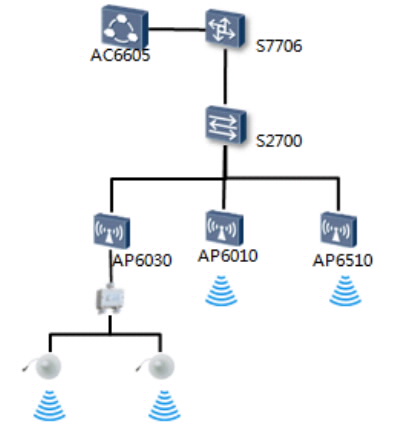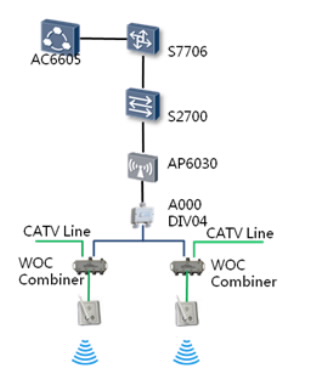Application Scenarios
With the development of information technology, more hotel guests want to access the Internet through their smart phones or tablets, anytime and anywhere. Wireless networks offer high mobility, strong flexibility, and rapid deployment. They can provide guests with convenient mobile office and on-line entertainment in hotel rooms, meeting rooms, restaurants, gardens, or at poolside.
Solution overview
For hotel wireless network deployment, Huawei recommends using a wireless Access Controller (AC) and thin Access Point (AP) deployment. The wireless access controller connects to the core switches and is responsible for Radio Frequency (RF) management of the wireless network. It automatically configures the entire network APs and the eSight network management system, RF management, channel allocation, access control and management, server authentication, wireless access guest authentication, authorization, and billing functions. Huawei recommends using divided deployment in guest rooms, to reduce hotel investment costs, and installing in public areas like lobbies, restaurants, and other areas for guest satisfaction and good wireless signal coverage.

Wireless Network Solution
1. Advanced AC and thin AP network architecture enables convenient operation and efficient hotel wireless maintenance.
AC and thin AP wireless network architecture and the Huawei eSight wireless network management module can enable AP unified configuration and centralized management, through the wireless network wizard-based configuration, with accurate positioning and rapid fault recovery to enhance operator efficiency. Further, centralized radio frequency management for the APs through the access controllers and Huawei’s advanced optimization algorithms and intuitive network optimization adjustment methods enable wider wireless coverage, easily wireless roaming, and more intelligent load balancing.
2. Diverse and flexible AP deployment ensures complete hotel wireless coverage.
Due to unified equipment selection and deployment, the Huawei wireless solution for hotels significantly improves user experiences. Depending on the hotel environment, Huawei can provide four AP deployment methods, including installing a Wide Area Local Area Network (WLAN), a WLAN combined with 2G/3G, a WLAN combined with Cable Television (CATV), and an indoor WLAN distribution. This shortens the construction cycle and increases wireless coverage.
3. Elaborate user group control strategy provides safer, isolated access.
The Huawei hotel wireless solution uses a self-developed user group control policy, which is more powerful than a typical Access Control List (ACL) function, controlling not just access isolation for guests with the same Service Set Identification (SSID), but also uses a black and white list to control access permissions and speeds for each guest. This management fine-tuning makes the hotel wireless network security isolation simpler and more efficient, eliminating the potential for guest information to be stolen from the access side and safely isolating the guest room and office network.
4. Intelligent multi-user schedules ensure stable user access.
If multiple users simultaneously access the same AP, network performance declines. Intelligent multi-user scheduling technology perceives the number of users in real time, ensuring speed and stability in high-density environments with multi-user access. This helps hotels easily cope with multi-user access scenarios, such as in banquets and large meetings, adding value to hotel conference room rentals and satisfying guests.
5. Supports Wi-Fi Multi-Media (WMM) technology for higher quality wireless video experience.
The Huawei wireless network supports built-in Wi-Fi Multi-Media (WMM) wireless Quality of Service (QoS) technologies to enable new requirements for wireless audio and video services. The solution can provide high-quality wireless voice service and wireless video-on-demand services, without changing the existing wireless network structure or increasing the number of APs. The fast roaming layer 2 and layer 3 switching mechanism can ensure lower wireless voice call delays. Combined with end-to-end multi-cast management of the wired network, it can also reduce the occupancy rate of the wireless video-on-demand network bandwidth and provide guests with a new wireless audio and video experience, improving customer loyalty.




